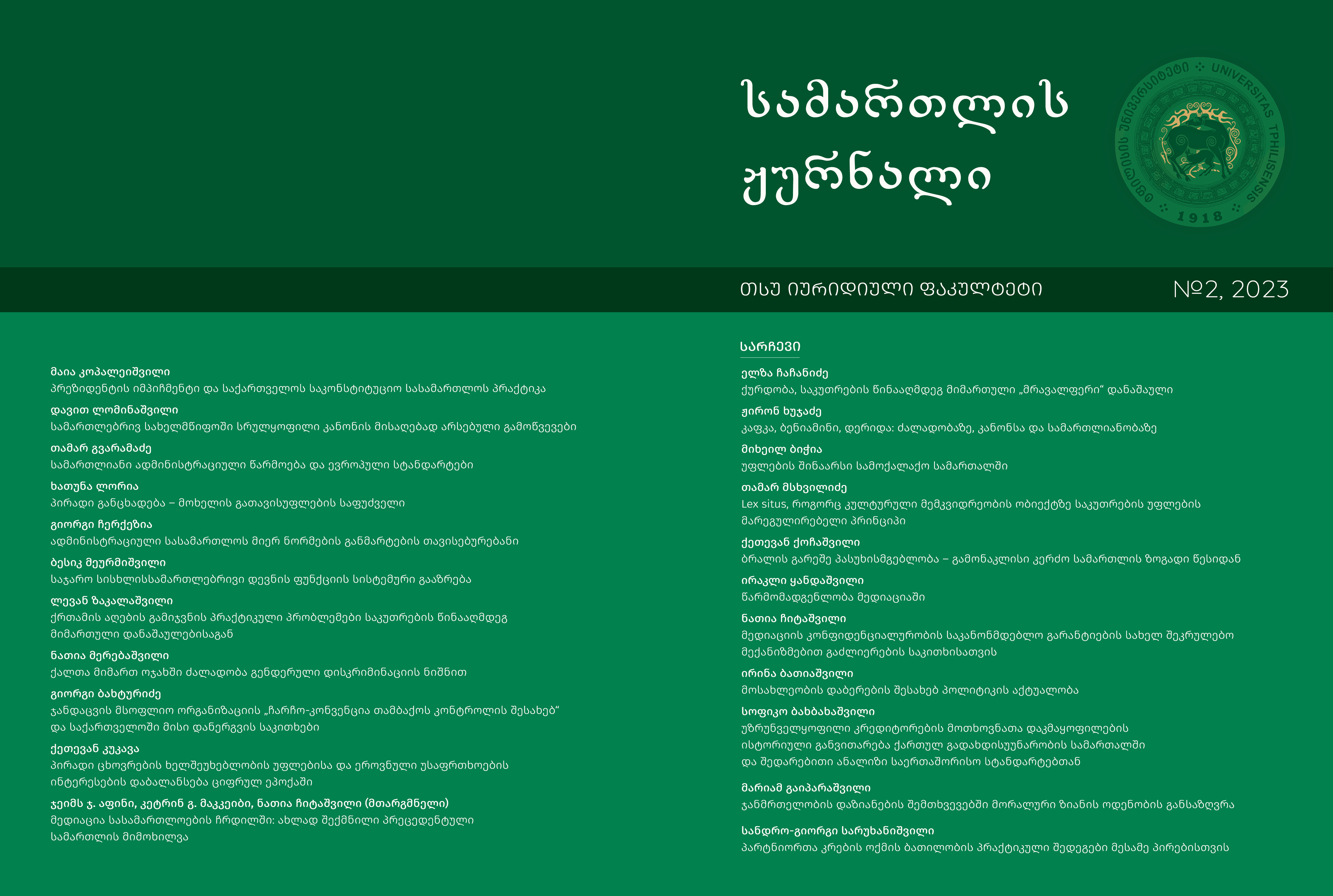Lex situs, როგორც კულტურული მემკვიდრეობის ობიექტზე საკუთრებისუფლების მარეგულირებელი პრინციპი
DOI:
https://doi.org/10.60131/jlaw.2.2023.7694საკვანძო სიტყვები:
სამართლის არჩევა, იურისდიქცია, კულტურულ ობიექტთა უკანონო ვაჭრობა, კეთილსინდისიერი შემძენი, ნივთის ადგილმდებარეობის კანონი.ანოტაცია
კულტურული ფასეულობებით არაეთიკური, ამორალური ვაჭრობა უკანონოა უმეტეს სახელმწიფოებში. კომერციული იმპერატივი არ არის მგრძნობიარე კულტურული მასალების გადინების, კულტურის თაობებზე გადაცემის მნიშვნელობის ან იმ ობიექტთა თავისუფალი გადაადგილების კონტროლის აუცილებლობის მიმართ, რომელთა დაცვას საფრთხე ემუქრება. სიძველეებზე მოთხოვნა მნიშვნელოვნად აღემატება შემცირებულ ლეგიტიმურ მიწოდებას. მომწოდებლები (მძარცველები, დილერები, შუამავლები) თავს არიდებენ კანონის მოთხოვნებს ტრანსნაციონალური გარიგებების დადებისას. საერთაშორისო კერძო სამართალს მნიშვნელოვანი როლის შესრულება შეუძლია კულტურული ობიექტების ტრანსსასაზღვრო გადაცემის მოწესრიგებაში.
წყაროები
Baudrillard J., The Conspiracy of Art, tr A Hodges, The MIT Press, 2005, 65.
Belder L., The Legal Protection of Cultural Heritage in International Law and its Implementation in Dutch Law, 2013, 22, 24, 66.
Feilden B.M., Jokilehto J., Management Guidelines for World Cultural Heritage Sites, ICCROM, 2nd Edition, 1998, Rome.
Fincham D., Rejecting Renvoi for Movable Cultural Property: The Islamic Republic of Iran v. Denyse Berend International Journal of Cultural Property, 2007, 111-116, 112, 114.
Fincham D., How Adopting the Lex Originis Rule Can Impede the Flow of Illicit Cultural Property, Columbia Journal of Law and the Arts, 2009, 115, 118, 120.
Gazzini I.F., Cultural Property Disputes: The Role of Arbitration in Resolving Non-Contractual Disputes, Transnational Publishers Inc, 2004, xxiii.
Gilkey L.B., Can Art Fill the Vacuum in D Apostolos-Cappadona (ed), Art, Creativity and the Sacred, 1996, 187-189.
Roodt C., The Role of Private International Law in the Protection of Art and Cultural Objects, 2015, 3, 6, 16-17, 13, 35, 115.
Roodt C., Miller D.C., Stolen Cultural Property: Implications of Vitium Reale in Private Law and Private International Law, 2013, 1, 3-6.
Routledge C. F., International Law and the Protection of Cultural Heritage, 2010, 151.
Sadigh S., Cultural Heritage Network, Court of London Ignores Iran’s Ownership of Achaemenid Bas-relief, 2007, 132.
Symeonides S. C., The American Choice-of-Law Revolution: Past, Present and Future, Martinus Nijhoff Publishers 2006, 15-24.
Staker C., Public International Law and the Lex Situs Rule in Property Conflicts and Foreign Expropriations, 58 Brit. Y.B. Int’s L., 1988, 151, 164.
Tolstoy L., What Is Art? The Brotherhood Publishing Company, 1898, 210.
Kreder J.A., The New Battleground of Museum Ethics and Holocaust-Era Claims: Technicalities Trumping Justice or Responsible Stewardship for the Public Trust? Oregon Law Review, Vol. 88, 2009, 65-72.
Press Office of the Federal Government Commissioner for Culture and the Media / Press and Information Office of the Federal Government, 11044 Berlin, Key aspects of the new Act on the Protection of Cultural Property in Germany, 2016.
ჩამოტვირთვები
გამოქვეყნებული
როგორ უნდა ციტირება
გამოცემა
სექცია
ლიცენზია

ეს ნამუშევარი ლიცენზირებულია Creative Commons Attribution-ShareAlike 4.0 საერთაშორისო ლიცენზიით .









